Our Japanese Kitchen series reaches its sixth instalment where we visit Ishikawa Prefecture in the Hokuriku region of western Honshu. Ishikawa Prefecture is well known for its variety of well-preserved traditional arts and crafts, from gold-leafing and the pottery of Kanazawa/Kaga (a combination of which can be seen in our current exhibition at the embassy GOLD: ALL THAT GLISTERS), to the famous lacquerware of Wajima in the Noto peninsular.
|
Yawaragi Omurice (omelette and fried rice)
By Dipika Soni, Japan Information and Cultural Centre |
My colleagues have so far introduced various famous local dishes in our Embassy's Japan Kitchen series, but there are many well-loved dishes which arguably have no 'real' local roots. One such dish is called "Omurice" (a simple dish of fried rice wrapped with an omelette). It is considered to be an all-Japan speciality, described as " yoshoku" (Western-influenced Japanese cuisine) rather than " washoku" (traditional style). However, I was intrigued when a small town in Ishikawa Prefecture, with which I have a long-standing connection, launched its Omurice no sato (home of omurice) project in 2011.
|
Ishikawa Prefecture is a peninsula located on the western coast of Japan's main island of Honshu. Although slightly off the beaten track for most foreign tourists to Japan, it is well known for its rich history and beautiful scenery. In the capital city of Kanazawa especially, you can witness many well preserved samurai and tea districts, and the region is noted for its traditional crafts including kimono silk dying, gold leafing and lacquerware.
The promotion of Kanazawa and its many tourist attractions has been in full force of late as a new shinkansen service is due to start running between Tokyo and Kanazawa in 2015, reducing the journey time to the region by almost half. As we approach the 50th anniversary of the first shinkansen, this new high-speed train is being eagerly anticipated.
|
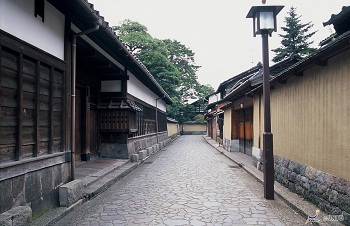 Nagamachi samurai district in Kanazawa
(photograph courtesy of JNTO)
Nagamachi samurai district in Kanazawa
(photograph courtesy of JNTO)
|
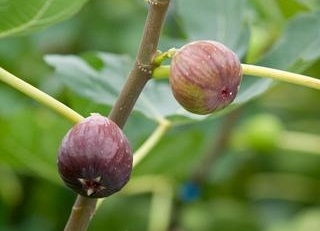 Photograph courtesy of Hodatsushimizu Town
Photograph courtesy of Hodatsushimizu Town. |
In addition to Kanazawa City, the Noto Peninsular of Ishikawa Prefecture is also well worth a visit, in particular for its spectacular views and untainted countryside. My own connection with Ishikawa came about when, as a successful applicant on the Japan Exchange and Teaching (JET) Programme, I was placed as an Assistant Language Teacher (ALT) in a town at the start of the Noto Peninsular called Hodatsushimizu.
The town, situated on one side along a stretch of the coast known as the "Nagisa Driveway" (famous for being the longest drivable beach in Japan), also boasts the highest mountain of the Noto area - Mount Hodatsu. Many different and delicious kinds of fruit and vegetables are grown around this area, but the town is known in the region for its large harvest of figs each year. |
However, it is the town's recent Omurice no sato project (Japanese only) that has been drawing in more and more visitors over the last few years. One famous story about the origin of omurice is that a young chef from Hodatsushimizu Town called Shigeo Kitahashi created the dish while working in a restaurant which later became " Hokkyokusei" (The North Star) in Osaka, sometime in 1925. |
It is said that one regular customer, who had a weak constitution, would always order the same dish of omelette and plain rice. Feeling sorry for him, and being a bit of an "ideas man", one day Kitahashi decided to serve him something a bit different. Mixing mushrooms and onions with tomato ketchup and rice, he wrapped the mixture in an omelette and served it to the customer, who is said to have been delighted with the dish. On being asked what the dish was called, it is said that Kitahashi replied, "Well, it's omelette and rice together, so it's called omurice!"
To this day, a bronze statue of Kitahashi stands in Yawaragi no Sato park in Hodatsushimizu, where he stands in a pose pointing to the North Star. Kitahashi's eldest son now runs the restaurant in Osaka, and with the launch of the Omurice no sato project in Hodatsushimizu, he developed a recipe for Yawaragi Omurice, which makes use of local produce.
Along with promoting this recipe, the Omurice no sato project works with local cafes and restaurants, who have developed their own unique omurice for their menu. You can try a range of different types from carbonara omurice to omu-maki sushi!
|
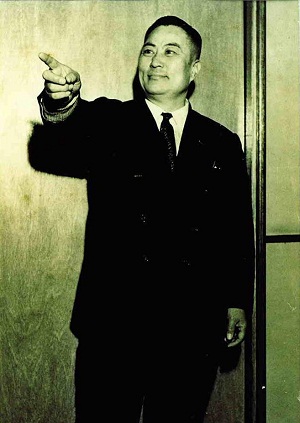 Shigeo Kitahashi (1900 - 1966).
Photograph courtesy of Hodatsushimizu Town
Shigeo Kitahashi (1900 - 1966).
Photograph courtesy of Hodatsushimizu Town.
|
Below I have shared the official recipe for Yawaragi Omurice translated into English. Although it uses some local products, these can be substituted for ingredients that you can find locally. Why not have a go at this recipe - or even try making your own take on omurice?!
|
Hodatsushimizu Town “Yawaragi Omurice” recipe
<Ingredients> |
<For the sauce> (for 10 servings)
Onion 100g
Carrot 50g
Green pepper 50g
Tomato juice (not spiced) 380ml
White wine a dash
Chicken stock cube 1 (consommé cube in original recipe)
Tomato ketchup 4 tablespoons
Roux - made from wheat flour and butter 30g of each (*Hodatsu kudzu 20g in original recipe)
Pepper to taste
Sugar 2 tablespoons
*Hodatsu kudzu is a local speciality of Hodatsushimizu Town. Kudzu is also called Japanese arrowroot and is available in some Japanese stores in the UK.
|
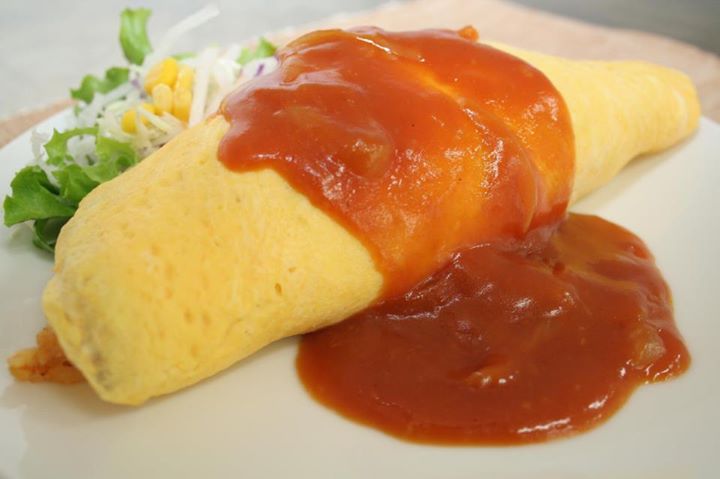 Photograph courtesy of Hodatsushimizu Town
Photograph courtesy of Hodatsushimizu Town |
<Instructions>
- Cut the onions, carrots and green peppers into small pieces. If using kudzu, dissolve it in a small amount of water.
- Lightly fry the onions, carrots and green peppers in a saucepan and add the white wine. Add the tomato juice, tomato ketchup, chicken stock cube and sugar.
- Place the oil and chicken in the pot and stir for 2 to 3 minutes.
- Bring the sauce to the boil and add the roux (or kudzu). Lastly, add pepper and salt (unless the tomato juice is already salted) to taste.
<For the omurice> (4 servings)
Chicken thigh 120g
Onion 2
Pak choi 1 bunch*
Raw shiitake 2*
Seasoning made from one tablespoon of white wine, 6ml of soy sauce, 9ml of Japanese rice wine**
Rice 500g (see our previous instructions for cooking rice here)
Egg 8
Salt and pepper to taste
Tomato ketchup to taste
*Local products are used in the original recipe
**Adding this enables the rice to hold together better
<Instructions>
- Cut the chicken thighs into small pieces of around 1cm in size.
- Heat one tablespoon of cooking oil in a frying pan and add the chicken. Lightly fry the chicken and then add a small amount of raw beaten egg. Add the onion and shiitake (finely chopped) and lightly fry. (Adding a small amount of raw egg absorbs any excess water from the mixture.)
- Add some slightly warm rice, salt, pepper and a small amount of your pre-prepared seasoning and cook well. Add pre-boiled pak choi and mix well.
- Add the ketchup to 2 and fry quickly. Turn off the heat as soon as it is mixed in. Make sure not to over-cook the mixture after the ketchup has been added.
- Heat some cooking oil in a large frying pan and add some beaten raw egg (about 2 eggs for one serving). Stir until half cooked.
- Place a quarter of the mixture in 3 on top of the egg in 4 and flatten out evenly. Turn off the heat.
- Fold the “omurice”. You can try the technique shown below.
- Add some of your “omurice sauce” as a garnish to finish.
|
Omurice folding technique:
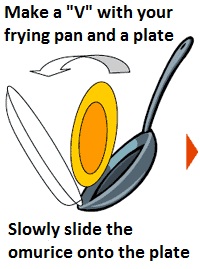 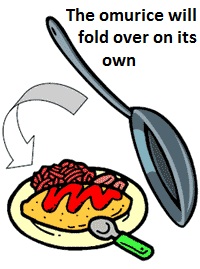
*If you still need some help, you can watch a demonstration video on YouTube here (Japanese only).
Enjoy!
|
| |
|

